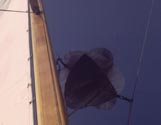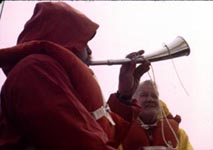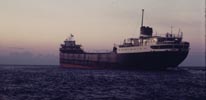A Sailing Story
From the Summer of 1970
Was I ever THAT skinny?
(First posted in 'rec.boats' newsgroup.)
 In my Uncle Ben's boat, coming down Lake Huron towards home,
we ran into a peculiar fog. It was in a steady wind of
about 20 kts and the visibility was rarely enough to
see the bow of the boat from the cockpit. Large droplets
striking the sails and rigging collected and poured into
the cockpit continuously. We ran the oven almost all the time
with clothes and shoes drying.
In my Uncle Ben's boat, coming down Lake Huron towards home,
we ran into a peculiar fog. It was in a steady wind of
about 20 kts and the visibility was rarely enough to
see the bow of the boat from the cockpit. Large droplets
striking the sails and rigging collected and poured into
the cockpit continuously. We ran the oven almost all the time
with clothes and shoes drying.
 This was in the days before GPS and even before affordable
LORAN, so we were navigating by ded reckoning, depthfinder,
and a not-too-reliable Heathkit radio direction finder.
We did have a home-made radar reflector which turned
out to be almost exactly like what Davis is selling these
days for their top-of-the-line RR.
This was in the days before GPS and even before affordable
LORAN, so we were navigating by ded reckoning, depthfinder,
and a not-too-reliable Heathkit radio direction finder.
We did have a home-made radar reflector which turned
out to be almost exactly like what Davis is selling these
days for their top-of-the-line RR.
 The wind was almost directly against us, so we were
"bouncing" off the Canadian shore with the depthfinder
(since the radio beacon geometry was poor on that side)
and using the RDF to "bounce" off the charted location
of the traffic separation scheme for the 500-1000' lake
freighters on the west side of the lake.
The wind was almost directly against us, so we were
"bouncing" off the Canadian shore with the depthfinder
(since the radio beacon geometry was poor on that side)
and using the RDF to "bounce" off the charted location
of the traffic separation scheme for the 500-1000' lake
freighters on the west side of the lake.
We had made good almost the full 200 miles of the north to
south length of the lake after four and a half days
without sighting anything farther away than our mast,
when we evidently pushed a little too far west.
 Through the fog we could hear the "clank-thump, clank-thump"
of one of the old steamers coming down the lake.
Alternating with our lung-powered reed-horn was the
sound of of a steam whistle sounding the fog signal.
We cupped our ears and listened to try and determine
where the freighter was and finally decided we should
come about rather than continue. When we did, there was
a horrendous cacaphony: the engine sounds
stopped for a moment and then went to twice the rate;
monstrous splashing and thrashing; the steam-whistle
switched to a series of short blasts! Then came the
only sighting we made until the fog lifted a day later:
Looking up at an angle of about 45 degrees we saw the
sternrail of the freighter gliding by us and below it
was the huge propeller thrashing in reverse, throwing
white water a hundred feet in the air, or so it seemed.
Through the fog we could hear the "clank-thump, clank-thump"
of one of the old steamers coming down the lake.
Alternating with our lung-powered reed-horn was the
sound of of a steam whistle sounding the fog signal.
We cupped our ears and listened to try and determine
where the freighter was and finally decided we should
come about rather than continue. When we did, there was
a horrendous cacaphony: the engine sounds
stopped for a moment and then went to twice the rate;
monstrous splashing and thrashing; the steam-whistle
switched to a series of short blasts! Then came the
only sighting we made until the fog lifted a day later:
Looking up at an angle of about 45 degrees we saw the
sternrail of the freighter gliding by us and below it
was the huge propeller thrashing in reverse, throwing
white water a hundred feet in the air, or so it seemed.
Evidently the pilot of the freighter could see us on
his radar and knew that our original course would clear,
although it would be close. Then we tacked right back
under his bow. Our best estimate by listening was that
he HADN'T seen us and that we were still short
of his path, but I guess we were wrong on both counts.
My uncle is gone, my father is over 80, my cousin and I are
well over 50, but we still remember that trip.
Happy to be here, thank you.
For those not familiar with the Great Lakes freighters,
here are a couple of pictures of one that I took a
few days later. Note that this boat, the John Dykstra (644'),
could NOT have been the one we encountered out in the lake,
since the JD was upbound, and the one we encountered was
downbound.


My Boating page
My home page
Created: Mon, Apr 18, 1995 11:05 AM
Modified: Mon, Dec. 22, 1997 3:48 AM
By: Peter W. Meek
Net-sig: --Pete <pwmeek@comcast.net>
pwmeek@comcast.net
 In my Uncle Ben's boat, coming down Lake Huron towards home,
we ran into a peculiar fog. It was in a steady wind of
about 20 kts and the visibility was rarely enough to
see the bow of the boat from the cockpit. Large droplets
striking the sails and rigging collected and poured into
the cockpit continuously. We ran the oven almost all the time
with clothes and shoes drying.
In my Uncle Ben's boat, coming down Lake Huron towards home,
we ran into a peculiar fog. It was in a steady wind of
about 20 kts and the visibility was rarely enough to
see the bow of the boat from the cockpit. Large droplets
striking the sails and rigging collected and poured into
the cockpit continuously. We ran the oven almost all the time
with clothes and shoes drying.
 This was in the days before GPS and even before affordable
LORAN, so we were navigating by ded reckoning, depthfinder,
and a not-too-reliable Heathkit radio direction finder.
We did have a home-made radar reflector which turned
out to be almost exactly like what Davis is selling these
days for their top-of-the-line RR.
This was in the days before GPS and even before affordable
LORAN, so we were navigating by ded reckoning, depthfinder,
and a not-too-reliable Heathkit radio direction finder.
We did have a home-made radar reflector which turned
out to be almost exactly like what Davis is selling these
days for their top-of-the-line RR.
 The wind was almost directly against us, so we were
"bouncing" off the Canadian shore with the depthfinder
(since the radio beacon geometry was poor on that side)
and using the RDF to "bounce" off the charted location
of the traffic separation scheme for the 500-1000' lake
freighters on the west side of the lake.
The wind was almost directly against us, so we were
"bouncing" off the Canadian shore with the depthfinder
(since the radio beacon geometry was poor on that side)
and using the RDF to "bounce" off the charted location
of the traffic separation scheme for the 500-1000' lake
freighters on the west side of the lake.
 Through the fog we could hear the "clank-thump, clank-thump"
of one of the old steamers coming down the lake.
Alternating with our lung-powered reed-horn was the
sound of of a steam whistle sounding the fog signal.
We cupped our ears and listened to try and determine
where the freighter was and finally decided we should
come about rather than continue. When we did, there was
a horrendous cacaphony: the engine sounds
stopped for a moment and then went to twice the rate;
monstrous splashing and thrashing; the steam-whistle
switched to a series of short blasts! Then came the
only sighting we made until the fog lifted a day later:
Looking up at an angle of about 45 degrees we saw the
sternrail of the freighter gliding by us and below it
was the huge propeller thrashing in reverse, throwing
white water a hundred feet in the air, or so it seemed.
Through the fog we could hear the "clank-thump, clank-thump"
of one of the old steamers coming down the lake.
Alternating with our lung-powered reed-horn was the
sound of of a steam whistle sounding the fog signal.
We cupped our ears and listened to try and determine
where the freighter was and finally decided we should
come about rather than continue. When we did, there was
a horrendous cacaphony: the engine sounds
stopped for a moment and then went to twice the rate;
monstrous splashing and thrashing; the steam-whistle
switched to a series of short blasts! Then came the
only sighting we made until the fog lifted a day later:
Looking up at an angle of about 45 degrees we saw the
sternrail of the freighter gliding by us and below it
was the huge propeller thrashing in reverse, throwing
white water a hundred feet in the air, or so it seemed.

